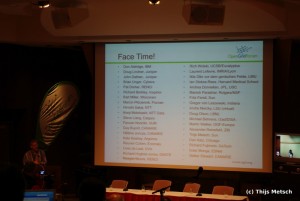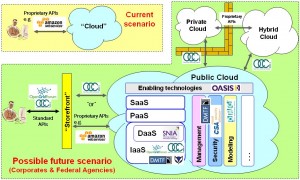March 19th, 2010 • Comments Off on Why Standards? – another point of view
During the past days there where several events where the topic ‘Why Standards’ was discussed. A writeup/summary of one of this events can be found here. Now read the following quote (out of context – I know :-)):
The people on standards bodies are in danger of speaking in an echo chamber. After a while, all they can hear is themselves
I do not agree with this. I will not comment on the ‘why standards’ and ‘we need standards for interoperability’ topics. But I want to raise one point: Why not see Standards bodies as Thinktanks? I mean so many people come together and bring in so many different opinions and points of views – which is very good so the solution (I do not call it standard now) will be cool (technology). I talked to so many people in the past days and all agreed that e.g. OCCI has some cool ideas. And we reached that by inviting all kinds of people with alls kinds of backgrounds to help create this cool thing. Okay we had our fights but somehow we reached consensus and I bet that a research lab of a company would have never come to the point where we are – just because they do not have all those different views.
Important is that you talk openly – if you have strict IPRs as a Standard Body and you’re not allowed to tell other people – you might indeed end up in ‘talking to yourself’.
Categories: Work • Tags: OCCI, OGF, Standards • Permalink for this article
October 27th, 2009 • Comments Off on The Cloud & Standards collaboration
Cloud Computing is a hype topic, most of you know that. Still there is a lot of interesting stuff going on during the past months and weeks. As one of the chairs of the OCCI (http://www.occi-wg.org) working group I had the great opportunity to present the status and some cloud related work during the Cloud Computing and its Applications conference. I was invited by Ian Foster to present the following slides:
What it comes done to is the following: During OGF27 (http://www.ogf.org/OGF27) we stated to present one of the first standardized Cloud interfaces. We are almost there and soon the specification will be out in the public comments phase of the OGF editor pipeline. More important than having one standard is to have the standards collaborate while each focus on a different aspect. For example the Cloud Data Management Interface driven by SNIA (http://www.snia.org). Now we need some more efforts like demos demonstrating interoperable and portable cloud solutions.
If you wanna know what is going on for OCCI right now: We had a lot of blog posts, mails, etc going on…
BTW the OCCI sessions during OGF27 itself went pretty well and both OCCI and myself have been in the closing remarks from Craig Lee:

Categories: Work • Tags: Cloud, OCCI, OGF • Permalink for this article
October 14th, 2009 • Comments Off on My slides for OGF27 about OCCI, the Cloud and HPCcloud
Categories: Personal, Work • Tags: GridEngine, OCCI, OGF • Permalink for this article
September 2nd, 2009 • Comments Off on Open Cloud Framework – Open Standards for the Cloud Community
Here is the talk I gave at GridKa School 2009 in Karlsruhe. Recordings will follow later – so stay tuned. The slides itself might not be to easy to read because they are designed for presentation not for Offline usage. But you’ll find a short transcript below…
- Introduction slide
- A very simple quote showing that not many people know what Cloud Computing is. Simon Wardley – found 68 definitions at his OSCON presentation.
- So what is cloud computing – cartoon shows that it is unclear and that Cloud Computing is not when you take an existing product and add a ‘Cloud Computing’ stamp on it. But these slides will define Cloud Computing using the RESERVOIR project acronym. The cartoon although is funny – the first line shows that adding public resources to your Private Cloud will create a big cloud. The second line shows that if you deinstall all software you will get Sun hardware 🙂 The third shows that if you have problem with your Cloud Sun will fix it.
- Intro to the FP7 EU Project RESERVOIR
- RESERVOIR stands for Resources and Services Virtualization without Barriers. So the 3 components are Resources, Services and Virtualization. If you combine them all without barriers you get Cloud Computing.
- Resources can be one of these nice Sun Blade Centers
- Services are any kind of Software with a demand for Services. The last think is important. Without the demand no Cloud. Next to that a Service has an Interface towards the End-user a Description consisting of Meta-information for the Semantic Cloud as well as requirements like CPU speed and architecture. Also a Service needs to have a SLA bound to it.
- Virtualization is basically an abstraction. And possible for Hardware (VirtualBox, VmWare,…), Software (Java), Storage (OGSA-DAI) or Network (Sun Crossbow).
- A lot of barriers need to dealt with.
- Sun doesn’t do this alone but with these RESERVOIR Project partners.
- Still what is Cloud Computing? This picture shows that it is everything and a kitchen sink. It is a lot and therefore we need more clarification based on Classification.
- The 3 major things which can be provided as a Service towards the customer are Software, Infrastructure and Platform as a Service. Important is that this is not a layered approach because you could offer SaaS on top of IaaS without PaaS…
- Several patterns of how users use the Cloud also show that Cloud Computing isn’t easy to describe
- The diversity also adds more confusion
- But one major thing of the Cloud is that you can do migration, consolidation and Hybrid-Clouds – so to say beeing elastic
- The RESERVOIR layered architecture
- Demoing the features fo such an environment – things Sun has demonstrated
- The Virtual Java Service Container is a unique entry point for all kind of Java Services. Those can be deployed and then managed/scaled in the environment
- The Exeds of a SGE cluster can be started and shutdown on demand.
- But the ‘blue arrows on slide #16 show that all this (elasticity, management etc.) is not possible without Standards. One is OGFs Open Cloud Computing Interface.
- A nice quote about standardization – design it to be extensible and think about the future
- It has 3 main drivers: Interoperability
- Portability
- Integration
- Focus on IaaS/virtual workloads
- If you have a lot of people you will have also some great minds onboard who can help
- 190 Members and a lot of active members/implementors and chairs are helping out
- The timeline to create a slim, extensbile API for the Cloud (And one of the first!) by OGF27
- The two devliverables of the OCCI working group
- The CRUD operations and mapping towards HTTP operations
- A diagram of OCCI. Maybe to complex to explain in text. Join the group or listen to one of the future talks about OCCI 🙂
- The most important slide. Having only one standard doesn’t help. It helps having one interface to ‘combine’ Clouds but what happens with e.g. secure data (top left)? So there is a demand for other standards. Those are shown in the big Cloud. More are also there. So please: join and help those groups! Without these the Cloud will not be possible (think of the barriers and elasticity)
- If it doesn’t happen Mankind will also die off…
- References and questions
Categories: Personal, Work • Tags: Cloud, OCCI, OGF, Standards • Permalink for this article
August 12th, 2009 • Comments Off on In the clouds – busy weeks
It have been some busy weeks. But great things have happen over the past weeks. The OCCI working group which tries to deliver one of the first standards in the cloud community is moving along very well. We have almost finished our first document describing the use cases and requirements for a Cloud API. This API should be capable of deploying, managing and monitoring virtual workloads (like virtual machines) in a Cloud. The draft can be found on our website: http://www.occi-wg.org. BTW there is a small one-pager describing OCCI. The draft of the specification can also be found on the OCCI website.
Next to that the cloud community is engaging to work together on cloud standards. The wiki on http://cloud-standards.org shows this. There is a nice overview (which might need some refinement) demonstrating where which standard might apply (I took if from the Wiki so it might be outdated).

Positioning of Cloud standards
Overall it seems that the work from SNIA, DMTF and OGF is coming together pretty nicely. For the last days I have been working on presentations and papers to present the work done in OCCI and RESERVOIR. For example a paper forcloudcomp 09 describing howto use OCCI to get RESERVOIR and the SLA@SOI project interoperate. Also upcoming are talks about RESERVOIR, the Cloud in general and OCCI at GridKa school, Sun HPC workshop and other smaller events. Also a poster about the Cloud and the Sun Grid Engine, Service Domain Manager and RESERVOIR is on its way. So great times to be in the clouds…
Categories: Work • Tags: Cloud, OCCI, OGF • Permalink for this article

